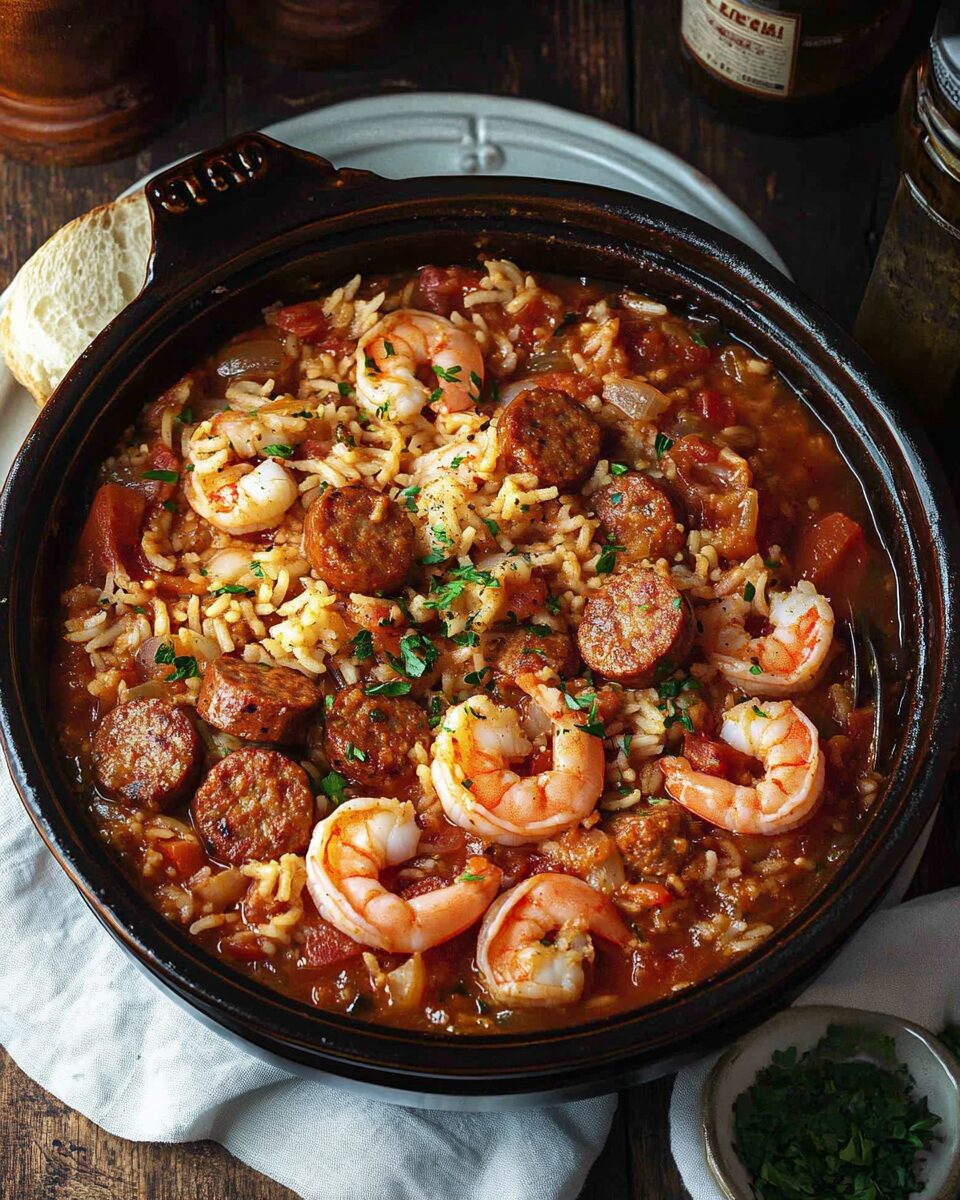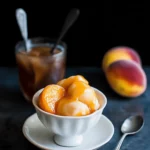This hearty and flavorful Slow Cooker Jambalaya with Sausage and Shrimp is a one-pot dish that combines the bold flavors of sausage, shrimp, and seasoned rice, all cooked to perfection in your slow cooker. It’s an easy and comforting meal, perfect for busy weeknights or gatherings.
FULL RECIPE
Ingredients
- 1 lb smoked sausage, sliced
- 1 lb shrimp, peeled and deveined
- 1 onion, chopped
- 1 bell pepper, chopped
- 2 celery stalks, chopped
- 3 garlic cloves, minced
- 1 can (14.5 oz) diced tomatoes, undrained
- 1 ½ cups long-grain rice, rinsed
- 2 cups chicken broth
- 1 tsp paprika
- 1 tsp thyme
- 1 tsp oregano
- 1 tsp cayenne pepper (optional for spice)
- Salt and pepper to taste
- 2 bay leaves
- 1 tbsp olive oil
Directions
- Heat olive oil in a skillet over medium heat. Add sausage and cook until browned. Transfer to the slow cooker.
- In the same skillet, sauté onion, bell pepper, celery, and garlic until softened. Add to the slow cooker.
- Add the diced tomatoes, chicken broth, rice, paprika, thyme, oregano, cayenne pepper (if using), salt, pepper, and bay leaves to the slow cooker. Stir to combine.
- Cover and cook on low for 4-5 hours, or until rice is tender.
- In the last 30 minutes of cooking, add the shrimp to the slow cooker and stir gently. Cook until shrimp are pink and cooked through.
- Remove the bay leaves, stir the jambalaya, and serve hot.
Nutritional Information
- Calories: 380 per serving
- Protein: 28g
- Carbohydrates: 38g
- Fiber: 3g
- Fat: 14g
- Sodium: 900mg
Slow Cooker Jambalaya: A Flavorful One-Pot Meal
Slow Cooker Jambalaya with sausage and shrimp is the perfect solution for those who crave a hearty and flavorful meal with minimal effort. This dish is a vibrant blend of meats, vegetables, and rice, all slow-cooked to perfection in one pot. The combination of sausage and shrimp creates a delightful balance of savory, smoky, and fresh flavors, making this jambalaya a crowd-pleasing dish that works well for family dinners or entertaining guests. The use of a slow cooker allows the flavors to meld together while saving you time and effort in the kitchen. Whether you’re preparing it for a weeknight meal or a weekend gathering, this jambalaya will surely become a favorite in your recipe rotation.
The Rich History of Jambalaya
Jambalaya has deep roots in Louisiana, influenced by both French and Spanish cuisine. It originated as a way to make use of available ingredients like rice, vegetables, and meats. Over the years, the dish has evolved, incorporating local ingredients and seasoning styles. The classic jambalaya comes in two main variations: Creole and Cajun. The Creole version often includes tomatoes and seafood, while the Cajun version is made with a darker roux and a focus on meat like chicken and sausage. Slow Cooker Jambalaya with sausage and shrimp is a modern twist that captures the essence of the original dish, making it accessible to those who enjoy the flavors of Louisiana but want an easy, hands-off cooking process.
Why Use a Slow Cooker for Jambalaya?
Using a slow cooker for jambalaya is a game-changer. It allows the rice to absorb all the rich flavors from the sausage, shrimp, and seasonings over several hours. This cooking method also ensures that the sausage becomes tender and flavorful, while the shrimp stays perfectly cooked without becoming tough. The slow cooking process also helps develop deep, savory flavors that would be harder to achieve in a shorter cooking time. By allowing the dish to cook slowly, you have more flexibility with your time and don’t need to stand over the stove constantly stirring or checking the dish.
The Importance of Seasoning in Jambalaya
Seasoning is key when it comes to making jambalaya. The blend of spices such as paprika, thyme, oregano, and cayenne pepper gives the dish its signature bold, spicy flavor. These spices work together to enhance the natural flavors of the sausage and shrimp while also complementing the vegetables. One of the unique aspects of jambalaya is its ability to be customized with the seasonings you enjoy most. Some might prefer it spicier, while others might prefer a more subtle heat. Adjusting the seasonings to your taste is part of the fun of making this dish.
Choosing the Right Sausage for Jambalaya
The sausage is an integral component of jambalaya, and the type of sausage you use can significantly impact the flavor. Smoked sausage is a popular choice because of its smoky, savory profile that infuses the entire dish with depth. Andouille sausage, a staple in Cajun cooking, is another excellent option if you’re looking for a bit more spice and a stronger flavor. However, feel free to experiment with other varieties based on your preference. Whether you opt for a mild or spicy sausage, it’s important to cook the sausage beforehand to render some of the fat and intensify its flavor before adding it to the slow cooker.
The Role of Shrimp in Jambalaya
Shrimp brings a fresh, slightly sweet flavor that balances the richness of the sausage in this dish. It’s important to add the shrimp towards the end of the cooking process to ensure that they don’t overcook and become rubbery. The shrimp absorbs the flavorful broth, adding to the overall complexity of the dish. Whether you use fresh or frozen shrimp, make sure they are peeled and deveined for convenience. Additionally, the shrimp adds a lovely color contrast to the dish, making it even more visually appealing.
Rice: The Foundation of Jambalaya
Rice is the heart and soul of any jambalaya. In this slow cooker recipe, long-grain rice is the ideal choice as it remains separate and fluffy throughout the cooking process. It’s important to rinse the rice before adding it to the slow cooker to remove excess starch, which can make the dish too sticky. The rice will absorb all the delicious flavors from the sausage, shrimp, and seasonings, becoming a flavorful and satisfying base for the dish. Be mindful of the rice-to-liquid ratio to ensure that the rice cooks evenly and doesn’t become too dry or too soupy.
Vegetables That Complement the Dish
The combination of onion, bell pepper, celery, and garlic in this jambalaya creates a flavorful base for the dish. These vegetables are typically referred to as the “holy trinity” in Cajun and Creole cooking, and they add sweetness, depth, and aroma to the dish. The onions and bell peppers provide a slight sweetness, while the celery contributes a fresh, grassy note. Garlic adds an unmistakable richness that ties the dish together. These vegetables are sautéed before being added to the slow cooker to release their natural flavors, enhancing the overall taste of the jambalaya.
The Versatility of Jambalaya
One of the best aspects of jambalaya is its versatility. You can easily adapt the recipe based on your preferences or dietary restrictions. For example, you can swap out the sausage for chicken or use tofu as a substitute for shrimp to make a vegetarian version. Additionally, if you’re looking to add more vegetables, you can include ingredients like okra, carrots, or peas. The beauty of jambalaya is that it can be customized to suit a wide range of tastes and dietary needs, while still maintaining its core essence.
How to Make Your Jambalaya Spicier
If you love spice, there are several ways to elevate the heat level in your jambalaya. You can increase the amount of cayenne pepper, add a chopped jalapeño or two, or even include hot sauce to taste. Remember, it’s always better to start with a small amount of spice and gradually add more as needed, as you can always make it spicier but can’t undo the heat once it’s been added. The slow cooker will help meld the heat evenly throughout the dish, so each bite packs a flavorful punch.
Perfecting the Rice Texture
One of the challenges when making jambalaya is ensuring the rice has the perfect texture. Too much liquid can result in a mushy texture, while too little liquid can leave the rice undercooked. To avoid this, it’s essential to follow the recipe’s recommended liquid-to-rice ratio and adjust accordingly. If you find that the rice is still too firm after the recommended cooking time, you can add a bit more broth or water and continue cooking until it’s tender.
What to Serve with Jambalaya
Jambalaya is a one-pot meal that’s hearty and satisfying on its own, but there are several side dishes that pair wonderfully with it. A simple green salad with a tangy vinaigrette provides a refreshing contrast to the rich flavors of the jambalaya. Cornbread is another popular choice, offering a slightly sweet flavor and a soft, crumbly texture that complements the spicy dish. If you want something a little more indulgent, garlic bread or a buttery biscuit would also make a great accompaniment.
Storing and Reheating Leftovers
If you have any leftover jambalaya, storing and reheating it is easy. Allow the dish to cool to room temperature before transferring it to an airtight container. Refrigerate for up to 3-4 days. When you’re ready to enjoy the leftovers, simply reheat them in the microwave or on the stovetop, adding a splash of broth or water to prevent the rice from drying out. Jambalaya also freezes well and can be stored in a freezer-safe container for up to 3 months. Just be sure to defrost it thoroughly before reheating.
Adjusting the Spice Level for Different Preferences
Not everyone enjoys the same level of spice, so it’s important to adjust the seasoning to suit your guests or family members. If you’re serving a group with varying spice tolerances, consider offering hot sauce on the side so individuals can add as much heat as they like. Additionally, using a milder sausage or leaving out the cayenne pepper will help reduce the overall spice level in the dish.
How to Make Jambalaya Ahead of Time
Preparing jambalaya ahead of time is a great way to save time on busy days. You can assemble the dish in the slow cooker and refrigerate it overnight before cooking. Simply set the slow cooker to the appropriate time the next day, and you’ll have a delicious meal ready without much hassle. Jambalaya also benefits from resting for a few hours after cooking, as the flavors continue to meld together.
Advertisement
Why Slow Cooker Jambalaya is Ideal for Busy Families
Slow Cooker Jambalaya is an ideal dish for busy families because it requires minimal hands-on time. After adding all the ingredients to the slow cooker, you can go about your day without worrying about constant stirring or checking the dish. The slow cooker does the work for you, allowing you to focus on other tasks while the jambalaya cooks. This makes it a great option for busy weeknights when you need to get dinner on the table with little effort.
How to Make Jambalaya a Complete Meal
To make jambalaya a complete meal, you don’t need much more than the dish itself. However, for a more balanced meal, you can add a side of roasted vegetables or a light soup to start the meal. The richness of the jambalaya pairs well with something light and refreshing, so consider adding a simple citrus-based salad to provide balance. The combination of protein, vegetables, and rice in jambalaya already provides a good mix of nutrients, making it a satisfying and well-rounded dish.
Conclusion
In conclusion, Slow Cooker Jambalaya with Sausage and Shrimp is a versatile, flavorful, and easy-to-make dish that is sure to please any crowd. The slow-cooked flavors bring out the best in the ingredients, creating a delicious one-pot meal that is both satisfying and comforting. Whether you’re making it for a family dinner or hosting a gathering, this dish offers convenience, flavor, and the warmth of southern cooking. So grab your slow cooker and get ready to enjoy a mouthwatering meal that’s packed with bold flavors and a touch of Louisiana flair.






